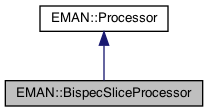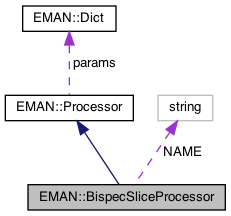This processor computes 2-D slices of the 4-D bispectrum of a 2-D image. More...
#include <processor.h>


Public Member Functions | |
| BispecSliceProcessor () | |
| string | get_name () const |
| Get the processor's name. More... | |
| void | process_inplace (EMData *image) |
| To process an image in-place. More... | |
| virtual EMData * | process (const EMData *const image) |
| To proccess an image out-of-place. More... | |
| string | get_desc () const |
| Get the descrition of this specific processor. More... | |
| TypeDict | get_param_types () const |
| Get processor parameter information in a dictionary. More... | |
 Public Member Functions inherited from EMAN::Processor Public Member Functions inherited from EMAN::Processor | |
| virtual | ~Processor () |
| virtual void | process_list_inplace (vector< EMData * > &images) |
| To process multiple images using the same algorithm. More... | |
| virtual Dict | get_params () const |
| Get the processor parameters in a key/value dictionary. More... | |
| virtual void | set_params (const Dict &new_params) |
| Set the processor parameters using a key/value dictionary. More... | |
Static Public Member Functions | |
| static Processor * | NEW () |
 Static Public Member Functions inherited from EMAN::Processor Static Public Member Functions inherited from EMAN::Processor | |
| static string | get_group_desc () |
| Get the description of this group of processors. More... | |
| static void | EMFourierFilterInPlace (EMData *fimage, Dict params) |
| Compute a Fourier-filter processed image in place. More... | |
| static EMData * | EMFourierFilter (EMData *fimage, Dict params) |
| Compute a Fourier-processor processed image without altering the original image. More... | |
Static Public Attributes | |
| static const string | NAME = "math.bispectrum.slice" |
Additional Inherited Members | |
 Public Types inherited from EMAN::Processor Public Types inherited from EMAN::Processor | |
| enum | fourier_filter_types { TOP_HAT_LOW_PASS , TOP_HAT_HIGH_PASS , TOP_HAT_BAND_PASS , TOP_HOMOMORPHIC , GAUSS_LOW_PASS , GAUSS_HIGH_PASS , GAUSS_BAND_PASS , GAUSS_INVERSE , GAUSS_HOMOMORPHIC , BUTTERWORTH_LOW_PASS , BUTTERWORTH_HIGH_PASS , BUTTERWORTH_HOMOMORPHIC , KAISER_I0 , KAISER_SINH , KAISER_I0_INVERSE , KAISER_SINH_INVERSE , SHIFT , TANH_LOW_PASS , TANH_HIGH_PASS , TANH_HOMOMORPHIC , TANH_BAND_PASS , RADIAL_TABLE , CTF_ } |
| Fourier filter Processor type enum. More... | |
 Protected Attributes inherited from EMAN::Processor Protected Attributes inherited from EMAN::Processor | |
| Dict | params |
Detailed Description
This processor computes 2-D slices of the 4-D bispectrum of a 2-D image.
It can also integrate over image rotation to produce a set of rotationally/translationally invariant slices
- Date
- 2017/07/04
- Parameters
-
kx Complex x coordinate of the slice ky Complex y coordinate of the slice jkx Instead of kx,ky, specify the sum Jx+Kx for the slice jky Instead of kx,ky, specify the sum Jy+Ky for the slice fp Compute a set of k=n rotational invariants and pack them into a single 2-D image stacked along y k Complex radial coordinate of the slice, integrates over angle at this radius size specifies the x.y dimension of the bispectrum image. Works by truncating high frequencies
Definition at line 734 of file processor.h.
Constructor & Destructor Documentation
◆ BispecSliceProcessor()
|
inline |
Member Function Documentation
◆ get_desc()
|
inlinevirtual |
Get the descrition of this specific processor.
This function must be overwritten by a subclass.
- Returns
- The description of this processor.
Implements EMAN::Processor.
Definition at line 753 of file processor.h.
◆ get_name()
|
inlinevirtual |
Get the processor's name.
Each processor is identified by a unique name.
- Returns
- The processor's name.
Implements EMAN::Processor.
Definition at line 739 of file processor.h.
References NAME.
◆ get_param_types()
|
inlinevirtual |
Get processor parameter information in a dictionary.
Each parameter has one record in the dictionary. Each record contains its name, data-type, and description.
- Returns
- A dictionary containing the parameter info.
Reimplemented from EMAN::Processor.
Definition at line 758 of file processor.h.
References EMAN::EMObject::FLOAT, EMAN::EMObject::INT, and EMAN::TypeDict::put().
◆ NEW()
|
inlinestatic |
◆ process()
To proccess an image out-of-place.
For those processors which can only be processed out-of-place, override this function to give the right behavior.
- Parameters
-
image The image will be copied, actual process happen on copy of image.
- Returns
- the image processing result, may or may not be the same size of the input image
Reimplemented from EMAN::Processor.
Definition at line 13324 of file processor.cpp.
References EMAN::Util::calc_best_fft_size(), get_ysize(), EMAN::Dict::has_key(), EMAN::Util::hypot_fast(), ImageDimensionException, EMAN::Processor::params, real(), EMAN::Dict::set_default(), sqrt(), x, and y.
◆ process_inplace()
|
inlinevirtual |
To process an image in-place.
For those processors which can only be processed out-of-place, override this function to just print out some error message to remind user call the out-of-place version.
- Parameters
-
image The image to be processed.
Implements EMAN::Processor.
Definition at line 744 of file processor.h.
References InvalidCallException.
Member Data Documentation
◆ NAME
|
static |
Definition at line 776 of file processor.h.
Referenced by get_name().
The documentation for this class was generated from the following files: